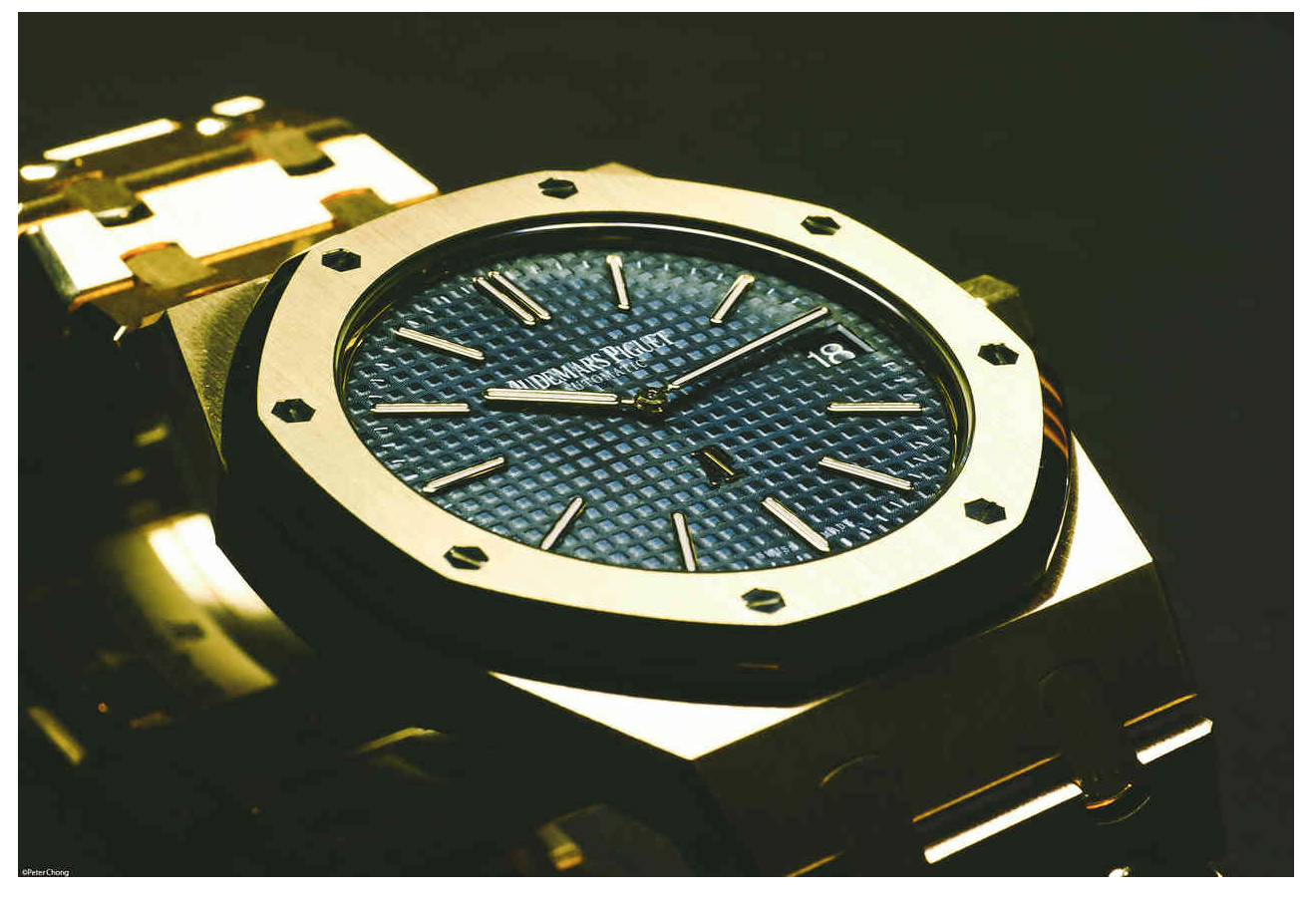Hate it or love it...it's on top.
The
Audemars Piguet Royal Oak watch has attained near-mythic status in the 40-plus years since it first sprang from the creative mind of designer Gérald Genta. In this time, it has saved a company from bankruptcy, established an entirely new genre of wristwatch, and graced the wrists of everyone from royalty to rap stars. And yet in spite of all this, it remains controversial, a polarizing design with as many people singing its praises as not. Indeed, for every die-hard fan of the Royal Oak, you'll find someone else who can hardly stand its sight.
Our view? We’ll admit—we love it. And if you’re smart, you do too.
1. It was designed in a day.
That's right, one of the most iconic watches ever designed was created in a day. Eerily divine? When the design brief was handed to young watch stylist Gérald Genta—a man who had already made a name for himself at companies like Universal Genève and Omega—he responded with the now-familiar octagonal case, replete with exposed mounting screws that would eventually become the Royal Oak. All in less than 24 hours.
2. The prototypes were made out of white gold.
One of the most contentious parts of the original Royal Oak was that it was crafted out of stainless steel, yet it still cost as much as, if not more, than contemporary watches made from noble metals like gold or platinum. And while it’s true that gold is well, gold, it’s a lot easier to work with than steel, which owes to its inherent softness and malleability.
In the run up to the Royal Oak’s debut at the 1972 Basel trade show, Audemars Piguet was still feeling its way around steel, and as such, they didn’t have time to develop the necessary tools and techniques to finish the Royal Oak’s complex case and bracelet to the exacting standards people had come to expect. So, what’d they do? They fell back on a metal that they had a lot of experience with. You guessed it. Gold.
3. An entirely new class of watch was created.
Prior to the introduction of the Royal Oak, “sport” watches were anything but luxurious. Keep in mind that in the ‘70s, timekeeping was serious business and since cell phones were decades away, a watch on the wrist wasn’t considered an affectation—it was considered a necessity.
Watches of the era reflected this reality, and a Rolex Submariner or a Blancpain Fifty-Fathoms were designed to be used and abused—practicality and durability were an absolute given.
The Royal Oak was conceived from the outset to be a luxury item with a superlative level of hand-finishing previously limited to dress watches and haute horology pieces. It was also meant to be water-resistant to satisfy its jet-setting owner on adventures around the globe.
4. It was almost called the “Safari.”
Prior to settling on Royal Oak as the official name, the prototype floating around Audemars Piguet’s office was nicknamed “Safari,” in part because of its overtly sporting pretensions that evoked images of desert exploration. Needless to say this didn’t stick, as the powers-that-be didn’t consider this name to be in keeping with the image of the brand.
5. ...30 years later, they made one called "Safari."
The model is based on the Royal Oak Offshore Chronograph, a super-sized version of the original.
6. It’s named after a royal oak tree.
The royal oak, to be specific, as in the EXACT tree whose branches King Charles II of England had hidden behind to escape the Roundheads following the Battle of Worcester in 1651. There have also been eight British naval warships christened “Royal Oak,” which has led some to believe that the inspiration for the design of the wrist-watch’s bezel was inspired by a ship’s porthole.
But actually...
7. Parts were inspired by a diving helmet.
Apparently after having received the design brief for what was to become the Royal Oak, Gérald Genta happened upon a diver emerging from Lake Geneva and thought to himself, If the screws holding the faceplate were strong enough to ensure a watertight seal on the helmet, surely they must be capable of doing the same for a watch.
8. Those screws are made out of gold.
It’s white gold, but they can look like yellow gold from certain angles because they’re too small to be rhodium-plated. And yes, they go straight through the case and hold the whole shebang together. (The screws are stainless steel on the Royal Oak Offshore.)
9. It took almost three years to sell the first 1,000.
The Royal Oak was anything but a runaway success, and indeed, many pundits in the industry predicted that it would spell Audemars Piguet's demise. After its official launch in 1972, a shocked world didn't know what what the hell to make of the angular design. A $3,600 price tag—in 1972, no less—was not only more than many gold watches, but also 10-times the price of a contemporary Rolex Submariner, the other steel icon on the market.
10. But then did it sell. A lot.
That it finally did is no secret, but what makes its success all the more sweet is that instead of driving Audemars Piguet into insolvency—which, like pretty much every other Swiss manufacture reeling from the effects of the so-called “Quartz Crisis," was—the Royal Oak saved the damn thing from total irrelevancy.
11. The first customer was royalty.
None other than the Shah of Iran, a man known for his taste for the finer things in life—b
e they palaces, cars, or women. He saw the potential of the Royal Oak, and made sure that one graced his wrist.
12. And he had to have it in white gold.
Please. The Shah of Iran wasn’t about to settle for any old Royal Oak. Never mind that part of the watch’s unique charm lay in its use of stainless steel, the Shah was very specific that his Royal Oak be made of white gold. Needless to say, Audemars Piguet obliged with a custom watch designed just for him.
13. It’s nicknamed “Jumbo.”
While the original Royal Oak may seem sleek and svelte by today’s standards—45mm diameter watches from the likes of Panerai are the norm—at 39mm, the Royal Oak was positively humongous for 1972 sensibilities.
14. The launch of the Offshore was expected to be a flop.
On the 20th anniversary, the Royal Oak Offshore debuted to the exact same ambiguous reception that its predecessor did. Once again, some of the criticism centered around the size of the watch, not only its diameter (42mm), but its thickness. Part of the reason for this
avoirdupois was the inclusion of a soft-iron inner case to protect the movement from the effects of magnetism. (Also there was visible rubber gaskets, a major departure from the original Oak and the luxury aesthetic.)
The public eventually came around, and much like the original, the Royal Oak Offshore came to redefine the luxury sport watch much in the same way that the “Jumbo” defined the genre in the first place.
15. And it almost wasn't made.
The designer, Emmanuel Gueit, had to chase down executives in hallways and ambush them while they were being whisked away in their cars to get the Offshore approved for production. Fast-forward to today, and you can count LeBron James, Jay Z, Michael Schumacher, and Arnold Schwarzenegger all wearing their own design on their wrists.
16. Its movement remains the thinnest automatic in the world.
Albeit with a few qualifications. When the 2121 calibre debuted in 1967 at just a hair’s breadth over 3mm, it was indeed the thinnest automatic movement the world had ever seen. In subsequent years, other manufacturers would manage to create ever so slightly thinner movements, but none of them would utilize a full-sized central rotor to maintain the power reserve. To this day, the calibre 2121 is still considered one of the finest mechanical watch movements ever produced.
17. Most are still made on 100-year-old machines.
Even the high-tech Royal Oak Offshore Forged Carbon Diver, which features an uber-strong carbon fiber case, scratch-proof ceramic bezel, and titanium caseback, still relies on old-fashioned methods to achieve its trademark dial finish.
This uniquely checkered “tapissiere” pattern that adorns the dials of many Royal Oak and Royal Oak Offshore models is the result of hours of dedicated labor. It begins with a 100-year-old rose-engine, a pantograph-type machine, where a guide runs over an enlarged version of the dial and carves out a similar pattern on the actual dial.
18. You can still buy the original Royal Oak "Jumbo."
Walk into an Audemars Piguet boutique to find the modern 15202 watch. Occasionally, the original 5402 from ‘72 can be found at auction or from dealers.
Adam Craniotes is a contributor to Supercompressor. His wife thinks he's more scoundrel than gentleman. The watch community thinks otherwise. Follow him on Twitter or Instagram to decide for yourself.















































